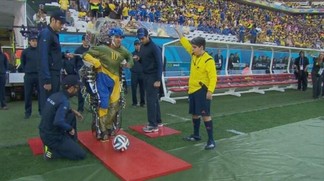Jun 16 2014
A young paraplegic equipped with a robotic exoskeleton kicked off the FIFA World Cup. Pioneered by an international team, the device benefits from a sensory feedback system developed at EPFL.

The exoskeleton weighs 60 pounds, is equipped with hydraulic motors and is controlled by thought through a helmet outfitted with electrodes. Presented at the opening of the 2014 World Cup ceremony, this device is the result of the international Walk Again Project. Directed by Miguel Nicolelis, this project brings together Duke University, the University of Kentucky, the University of California, the Technical University of Munich, the company BIA outside Paris, the International Institute of Neuroscience in Brazil and EPFL.
Restoring the perception of walking
The paraplegic patient in control of the exoskeleton is typically unable to know the position of his legs in space, the height of each step, or the intensity of his stride. Under such conditions, it is difficult to precisely coordinate the motion of walking. It was precisely to address this problem that EPFL researchers became involved.
As part of the NCCR Robotics team, Hannes Bleuler has developed a system to give the young patient – deprived of sensations below the pelvis – sensory information by transmitting it as vibrations to the upper body.
Sensory feedback on the forearm
Their system takes the form of electronic armbands placed on the forearm of the patient which generate vibrations when walking. Induced by sensors placed under the patient's feet, these vibrations vary in intensity depending on whether the foot is in contact with the ground or according to the position of the legs during the stride. At each step, the necessary information is transmitted to the pilot of the exoskeleton.
To function properly, the system requires some practice. Volunteers in Brazil have been training for months with a full environment in virtual reality (VR) that was developed by an EPFL researcher. This learning process allowed them to integrate the relationship between the different vibrations felt on the arms with the position of their lower limbs. In the end, it was proved possible to “feel” the pressure of the foot on the ground from heel to toe, or even to know the exact position of the leg when the foot leaves the ground between strides. This is how the exoskeleton is controlled with such fluidity and dexterity.
Author: Laure-Anne Pessina
Source: Mediacom